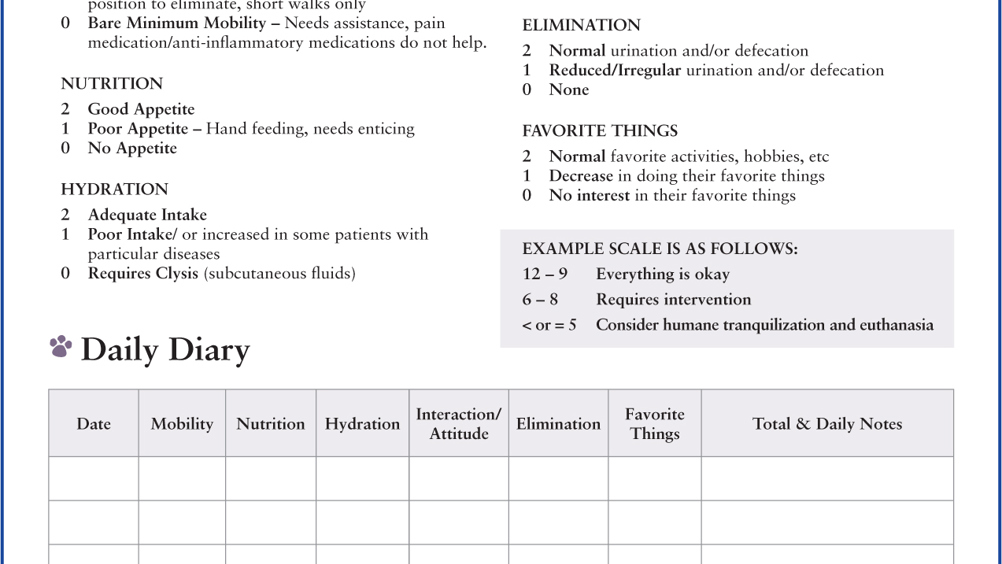Veterinary practitioners are often asked the questions ‘When is it time?’, ‘How will I know if they are suffering too much?’, ‘I'm not sure whether to put them through any more treatment.’ Often owners are told that they will know when the time comes, but often it is not that clear for the owner, and some patients just will not give a specific sign. Some owners will rely on their veterinary team to help support and guide them through the decision-making process (Mullan, 2015; Gardner, 2017).
Veterinary hospice care is ‘care for animals, focused on the patient's and family's needs; on living life as fully as possible until the time of death (with or without intervention); and on attaining a degree of preparation for death’ (International Association for Animal Hospice and Palliative Care (IAAHPC), 2019). Part of providing hospice care is assessing the quality of life that a patient is currently experiencing.
Quality of life (QOL) is unique to the individual, which means it is very subjective and hard to assess on a general scale. It is a multidimensional construct (Reid et al, 2015). QOL assessments can be useful for assessing a pet's QOL at a specific point in time, and after treatment has been given to assess effectiveness and acceptability (Pierce and Shannan, 2017). The QOL assessment sits within the patient-centred approach to patient care as ‘the QOL assessment must focus as much as possible on how the animal is doing from the animal's point of view’ (Pierce and Shanan, 2017: 28). Quantitative QOL scales can help provide a useful guideline for owners with patients that are in their end-of-life phase, and are relatively easy to implement (Villalobos, 2011).
There are several different QOL scales available for the veterinary team to use. During the case studies discussed below the Lap of Love Dr Gardner's Pet QOL scale (Figure 1) and H5M2 scale (Figure 2) were used. The Lap of Love Dr Gardner's Pet QOL Scale was developed in the USA by Lap of Love Veterinary Hospice and aims to help give some objective data on which to make judgments in relation to quality of life (Pethospicejournal.com, 2019). This QOL scale has six areas of focus: mobility, elimination, doing favourite things, interactions, eating and drinking. All are scored from 0–2 with examples provided for a score of 0, 1 or 2. It is a quick and easy QOL scale to introduce to owners in the author's experience, as it is not too long and the questions are short. Also owners can give responses up to 0.1 accuracy if they wish. The H5M2 scale (Figure 2), was first introduced in 2004 by Dr Alice Villalobos and is widely used in veterinary hospice. Also known as the Pawspice scale it has been gaining increasing recognition by veterinary professionals for its importance as a QOL assessment tool (Pierce and Shannan, 2017). This scale is a seven point scale asking owners to score between 0–10 for each of the seven items: hurt, hunger, hydration, hygiene, happiness, mobility and more good days than bad. This scale is user friendly and widely used, and in the author's experience takes a little longer to explain to clients each section, which can lead to more information, but also to more owner confusion. In the author's experience this scale can be useful where the client is not as communicative, as it opens up more conversation and will help in gaining valuable information. Ideally each patient should have at least a couple of different scales used each time, however from the author's experience discussing QOL can be quite emotionally challenging for owners, and the person conducting the quality of life score needs to consider this factor.
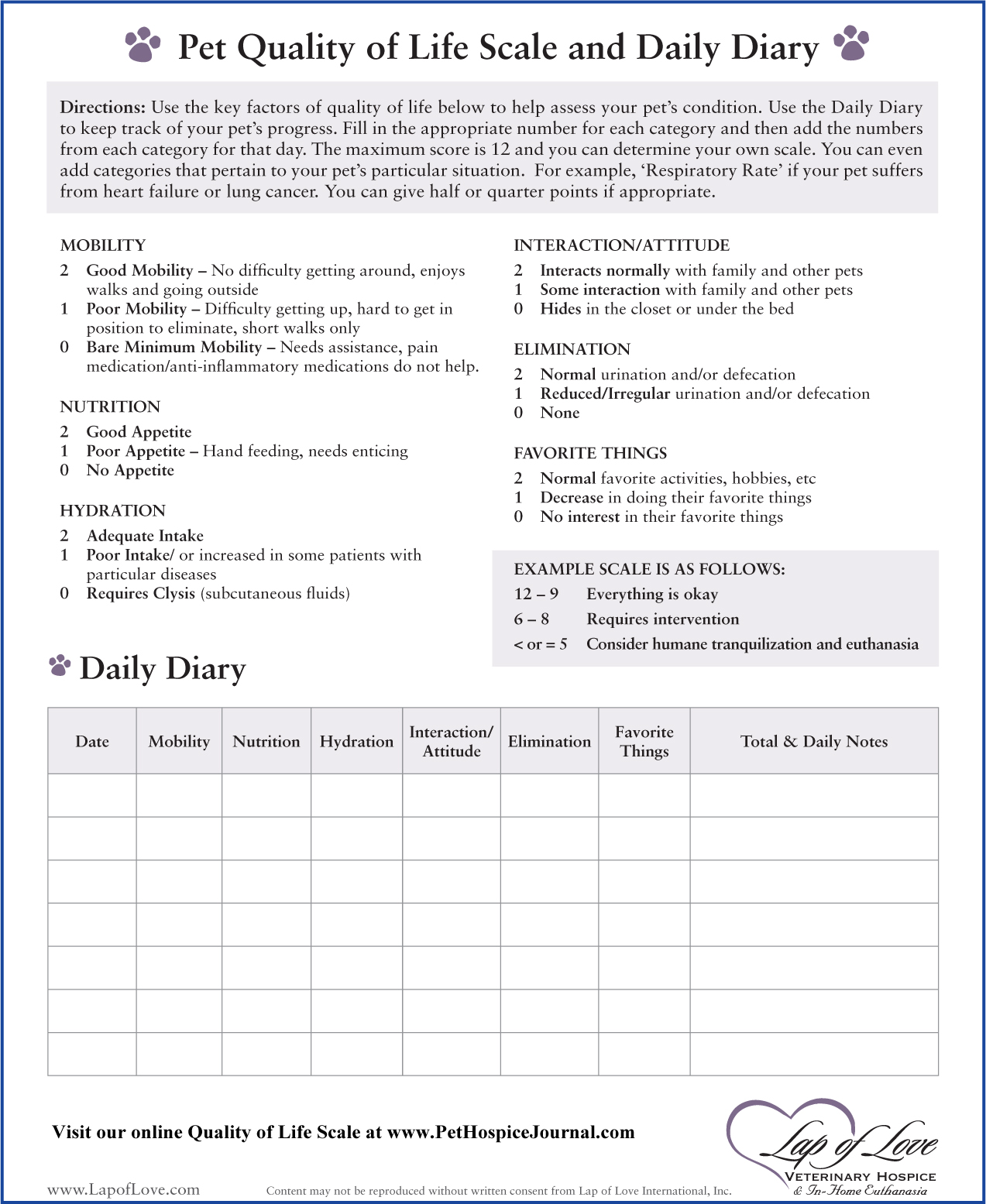
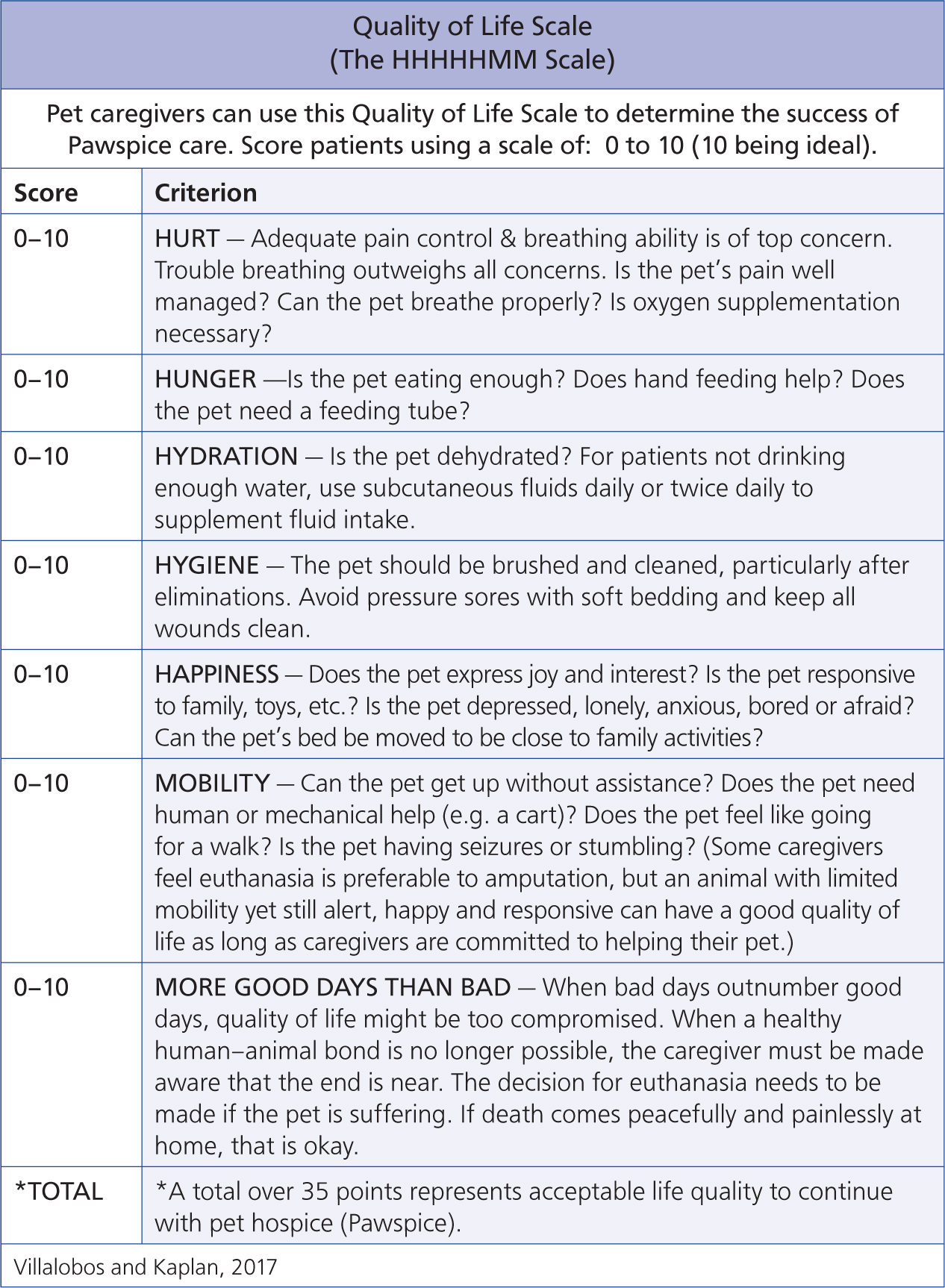
When approaching discussing a QOL scale with a client, the author always asks the owner if they feel comfortable doing this and gains their consent first. This is a conversation that should not be rushed and the client needs to feel safe to be able to properly look at their pet's current QOL. The author always uses a paper-based medium, as this, in her opinion, allows a better visualisation for the client, and also allows a better flow of empathetic conversation, even though there are now technology-based QOL assessment programmes (Reid et al, 2013).
Case studies
Patient A
Patient A is an 11-year-old female terrier cross. When the patient was first presented to the author's practice she had been suffering from pancreatitis and inflammatory bowel disease for several months. She was suffering from bouts of severe abdominal pain; during these episodes she had abnormal elimination, and was behaviourally withdrawn. The owner's goal for Patient A was to achieve a decent QOL, and she was concerned that the painful episodes were detrimental to this. The owner was unsure and concerned that Patient A's quality of life may not be good enough to persist with treatment. The Lap of Love Dr Gardner's QOL scale (see Figure 1) was used and initially this patient scored 8.9 out of 12. This put Patient A in the bracket of ‘intervention required’.
Patient A was prescribed tramadol (Tralieve, Dechra Veterinary Products) to be given twice daily, paracetamol twice daily, prednisolone (Prednicare, Animalcare) daily, and a ‘crisis kit’ consisting of buprenorphine (Vetergesic, Ceva Animal Health Ltd) pre-loaded syringes in case of an acute painful episode. A blood test for trypsin-like immunoreactivity (TLI), cobalamine and folate, and canine pancreatic lipase immunoreactivity (cPLI) was taken and the results were abnormal. A treatment course of Cobalaplex (Protexin Animal Health) capsule every other day and vitamin B injections weekly for 6 weeks was instigated, along with a low-fat diet fed little and often. As treatment progressed the patient showed a big improvement. She was no longer experiencing the painful episodes and was back to having normal elimination. Patient A was able to run around the garden and was very interactive with her owner and was no longer withdrawn.
After a couple of months the Lap of Love Dr Gardner's QOL scale was used to reassess the patient. This time Patient A scored 11.4.
This case is a good example of where the patient has demonstrated a significant increase in the quality of their life both through observation and through the QOL scale. The scale was able to provide the veterinary team with a measurable way of assessing improvement in patient welfare. It initially helped highlight to the owner that although intervention was required there was still an element of QOL to be able to work with and to improve. This owner was very good at being able to objectively assess their pet and was able to think critically, and even used an accuracy of up to 0.1 for their marking.
Patient B
Patient B was a 14-year-old male Labrador that was initially presented to the veterinary team as unable to stand. Although initially some improvement had been seen the author first met Patient B when he was struggling to stand for a second time. He was starting to lean against walls and was struggling with his movements more than before, with a noticeable sinking of the hocks when standing. He had a fair to good appetite as he would always eat his food, but it look him longer than before he first had his mobility issues. It was suspected that Patient B was suffering from osteoarthritis, however there was concern that a neurological element could be present also. Patient B was already on an analgesia plan of codeine (Pardale V, Dechra Veterinary Products), gabapentin and prednisolone (Prednicare, Animalcare) (the patient also had a pruritus) and the owner had become concerned that he had deteriorated further. The Lap of Love Dr Gardner's QOL scale (see Figure 1) was used to help assess current QOL. The QOL scale gave a score of 6 (Figure 3). The lowest scores were for mobility and elimination (he had been struggling to position himself for urination and the owner was concerned that he only urinated once a day). Scores between 6–8 suggest that intervention is required. This was also reflected in the BEAP chronic pain scores (Pethospice.com, 2019) conducted, and overall examination. A combination of generalised weakness, functional issues particularly affecting the hind legs, and pain were observed.
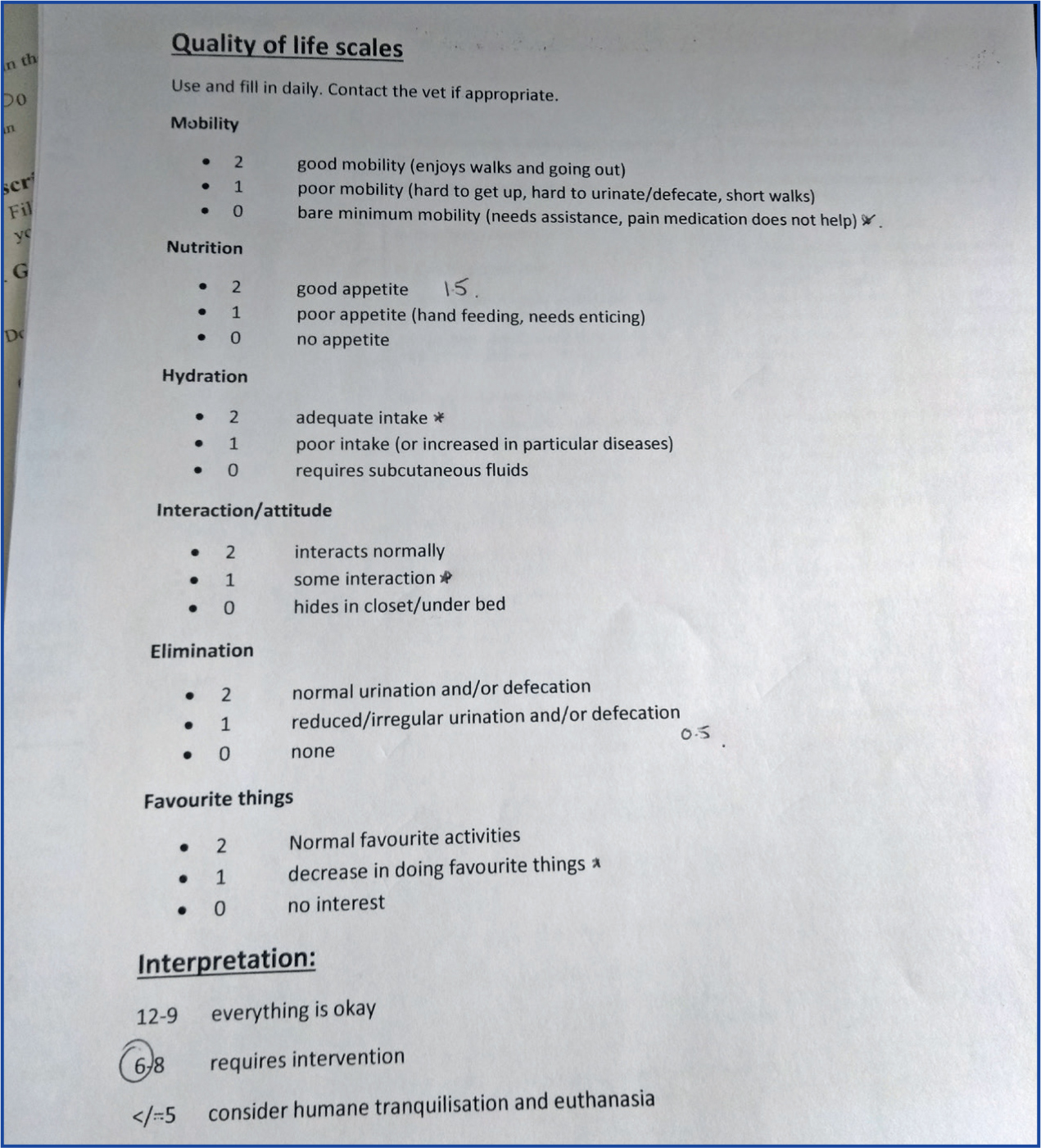
A new plan was implemented with an increase in analgesia, with gabapentin increased to three times daily and a crisis kit of gabapentin was also prescribed, and household changes were added to help support the patient. Rubber matts were introduced to reduce the risk of slipping, and a ramp was introduced to help Patient B be able to get into the back garden to eliminate. A sling was to be used to support Patient B when mobilising and an elevated water and food bowl was suggested so that he would not be putting so much pressure onto his fore legs. It was suggested to try calm stimulations such as harp music and an activity toy as a gentle way to keep Patient B mentally stimulated with something that he would enjoy.
A new QOL score was conducted 1 week later to see if there had been any improvement in the Patient B's QOL. The score again was a 6, however there were changes to the scoring such as the score for mobility, which had improved from a 0 to a 0.5, however appetite had decreased from 1.5 to 1 (Figure 4). This was very concerning for the owner as Patient B had always loved food and she felt that this change was especially detrimental to his wellbeing. He was no longer eating all of the food he was given, and was leaving an increasing amount in his bowl. The veterinary surgeon was unable to ascertain why Patient B's appetite had reduced, and the owner was concerned that emotionally Patient B was struggling with his reduced mobility and it was difficult to control his present pain levels. It was decided that Patient B was to have a planned home euthanasia. It was important to respect Patient B's owners decision as she was considering her own ability to continue the specialised care that Patient B would require, and that, although she would have wanted to, she was limited in being able to continue that level of care physically. Disease education, and letting Patient B's owner know that this would be a progressive disease, was important in allowing his caregiver to be able to make decisions.
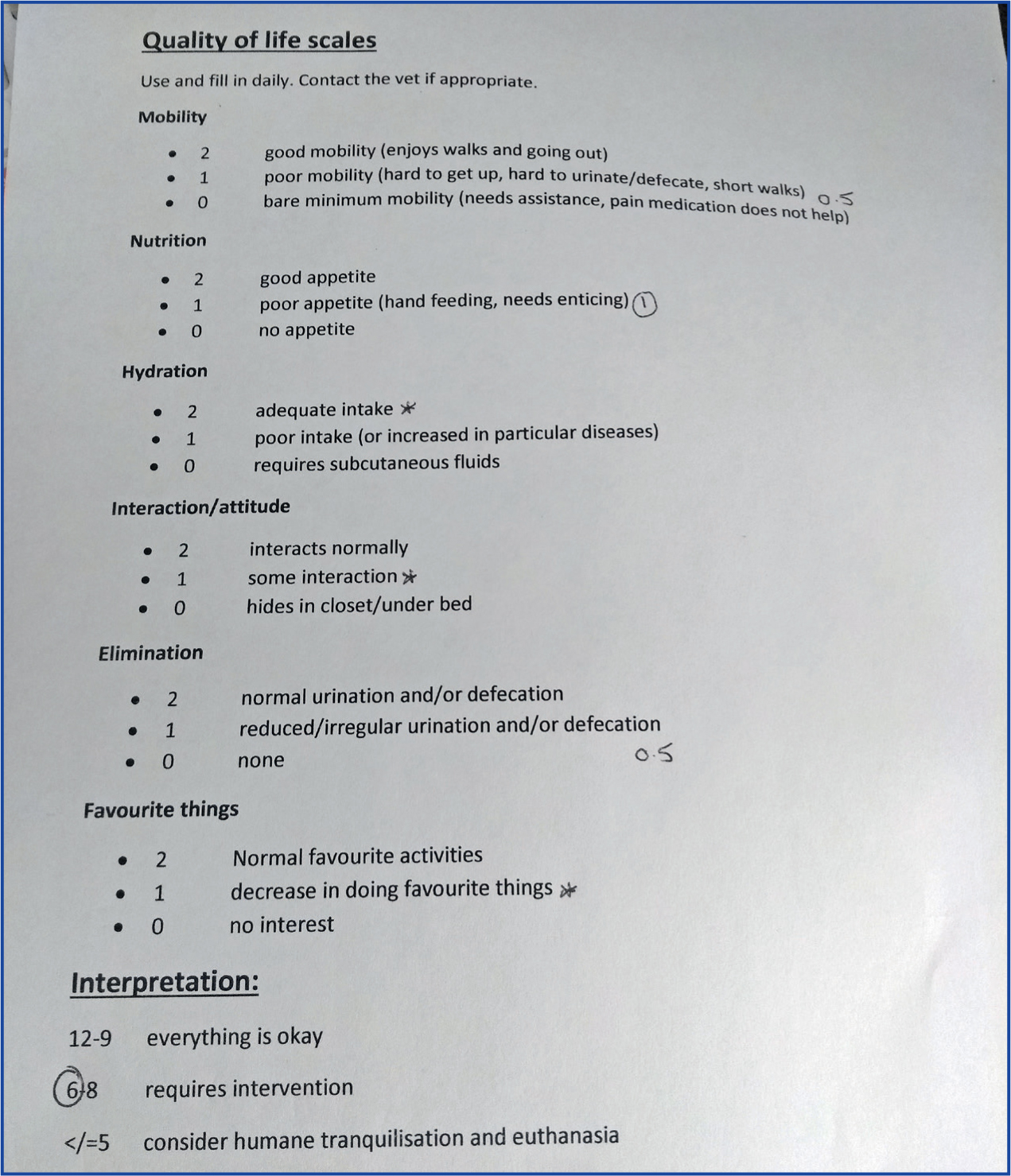
This case helps demonstrate that although the QOL scores were the same total (6/12) at both visits, the owner's outlook on how Patient B was coping had changed. The owner had priorities when it came to the QOL scoring, and a decrease in one of these priorities, food intake, was very difficult for Patient B's owner to cope with. Although Patient B's owner was highly dedicated to helping him, she also had some physical limitations, especially with Patient B's physical size in supporting him if he was to become completely immobile. Emotionally this pet was very significant to her as an owner, and this needed to be considered as well as the emotional needs of the patient. The QOL scoring in this instance helped the owner to reconcile with the fact that Patient B was struggling and that euthanasia may become an option if no improvement was seen.
Patient C
Patient C was a 10-year-old male German Shepherd Dog. Patient C was presented to the veterinary practice as he was struggling on his hind legs and had experienced vomiting and inappetance 3 days prior to the practice visit due to unknown origin. There had been no further vomiting or inappetance since. Signs of discomfort were evident on examination and on a BEAP chronic pain scale (Pethospice.com, 2019), and osteoarthritis was suspected. The veterinary surgeon assessed QOL using a H5M2 QOL scale (Figure 2). HHHHHMM stands for hurt, hunger, hydration, hygiene, happiness, mobility and more good days than bad. Each is given a score of between 0–10.
On initial presentation this patient scored 56 out of a possible 70. This score is above the level that represents an acceptable QOL (Villalobos A), however, it was clear that this patient did require intervention despite this score. An analgesia plan of meloxicam (Metacam, Boehringer Ingelheim), paracetamol and gabapentin were prescribed, and a follow-up appointment was scheduled for 2 weeks' time.
The author first encountered Patient C at the follow-up appointment. The owner reported that there had been a huge improvement following the introduction of a multimodal analgesia plan. The owner felt incredibly positive about Patient C's progress and just said that he was ‘fantastic’. On the H5M2 scoring at this visit the patient scored 67/70. This score felt artificially high, as though the score had been elevated by the client unintentionally. Although there were some mobility challenges, such as a hesitation to stand, the owner still felt strongly that mobility should be scored 8/10. The veterinary practitioner was able to recognise this as a potential score inflation from examination, however it is harder to ascertain markers such as hunger as this is purely down to the owner's observation. If one score is elevated artificially the practitioner has to consider whether other scores could be inflated too. Conducting a QOL score is a collaboration between the owner and veterinary professional. In this instance the owner felt very strongly about the mobility score, even when questioned about some behaviours that had been observed, e.g small hesitation when standing. This could be for a number of reasons, such as the owner not recognising that this could be a sign of discomfort, that this sign was not significant as their pet had been doing this for a long time, that the owner was not really aware of this or they were overlooking this sign. The veterinary professional recognised this behavioural indicator of pain and included it in the BEAP chronic pain scoring at this visit, and this was raised in the QOL conversation. There are a number of things that can cause an artificially high score: the scoring could have been affected by a different person asking the questions; more significantly, the owner's assessment may have been artificially elevated just due to the fact that there had been this large improvement. The owner had feared at the first appointment that Patient C would be euthanased so to see such a change would affect scoring as a result of the surprise and relief of the huge improvement seen.
In Patient C's case it would have been useful to the veterinary team if other owners had been able to conduct the score, as this could have lead to an average or a different option on Patient C's QOL. Having a family collaborate on QOL scoring is important so that a clearer picture of the pet's current QOL can be achieved. Sometimes different owners may have a different assessment depending on their involvement as a caregiver and their relationship with the pet.
Limitations
As seen from the case studies above there are some limitations to the use of QOL scales alone. Most QOL scales are concerned primarily with health-related measures (Mullan, 2015), such as appetite, elimination and mobility.
The 2016 AAHA/IAAHPC End-of-Life Care Guidelines define QOL as ‘the total wellbeing of an individual animal that considers the physical, social and emotional aspects of life’ (Bishop et al, 2016: 342).
With the two scales used in these case studies only one social and one emotional question was asked in the Lap of Love Dr Gardner's QOL scale, and in the H5M2 scale only one question combined the social and emotional aspects. This meant that due to the nature of the scales the weighting of the scores was not equal between social, emotional and physical needs and the majority of the scoring was in relation to the physical needs. It is also worth bearing in mind that specific ailments, such as blindness or epilepsy that could significantly affect QOL could easily fall outside the brackets of the questions. There is also the question of scoring a patient where, for example, they may need extra assistance with mobility, such as using a cart, but where the patient is happy mobilising in this way — how should such a patient be scored? This is where, in the author's experience, more in-depth discussion with the client is needed to ascertain how conditions such as these are affecting the patient day-to-day, and where in collaboration with the owner the pet can be treated as an individual.
It could also be that some elements should be deemed more important than others, for example, high pain levels may be so overwhelming that the other scores may no longer be significant (Mullan, 2015). Another element that is difficult to ascertain from a QOL scale alone is the needs of the caregiver: their expectations and their limitations when it comes to patient care at home.
The two QOL scales used in these case studies are subjective. There have been condition-specific QOL scales produced that have been quantifiable, such as the DIAQoL scale for diabetic cats, which can be used alongside traditional monitoring practices to help assess and improve QOL for patients with this specific condition (Niessen et al, 2019). Developments such as these are very welcome, however, in the author's opinion, it will be difficult to find a scale that is perfect for every individual.
Conclusion
In conclusion, QOL scales can be a useful tool when helping owners with decision making for hospice and end-of-life cases. QOL scores can help provide the owner (and veterinary team) with an overall impression of the pet's current QOL and show an improvement in a pet's condition if used before and after treatment. They should not be used as the sole decision-making tool as there are limitations. In the author's opinion QOL scoring should be used for every palliative, hospice and end-of-life patient in practice. Taking the time to gently discuss with an owner their pet's physical, emotional and social needs can help clients in making important decisions. Also explaining that they are a baseline, and not the sole tool for determining a patient's care plan or future, helps owners to relax and be able to express their opinions without the fear of saying the wrong thing and it being suggested that their pet be euthanased.
QOL assessments can help accomplish a patient-centred care plan that is a partnership between the caregivers, the patient and the practitioner to help ensure that decisions respect the patients' wants, needs and preferences (Pierce and Shanan, 2017).
KEY POINTS
- Quality of life (QOL) scales can be a useful tool when helping owners with decision making for hospice and end-of-life cases, however they should not be used as the sole tool due to their limitations.
- QOL scales can be introduced at different points of a pet's illness or life stage, and not just be reserved for end-of-life cases.
- Using a QOL scale allows conversation to open up about a pet's current challenges, and can lead to useful information in decision making.
- Having a QOL discussion needs to be client led. For example, ideally it would be beneficial to complete two different QOL scales, however this is a very emotional topic of conversation and the client may only be able to go through the questions once.
- QOL scales are a great tool to help accomplish a patient-centred care plan.


